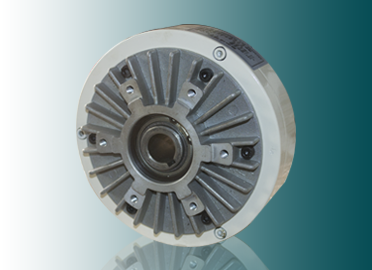At present, there are many types of motor loads for motor test systems on the market, such as eddy current brake loads, magnetic particle brake loads, hysteresis brake loads, and servo motor loads. Considering the characteristics and cost of the motor under test, it is very important to choose a suitable load, so how to choose a suitable load for the electrical test platform?
First of all, let’s understand the characteristics and working principles of various types of load brakes:
Eddy current brake
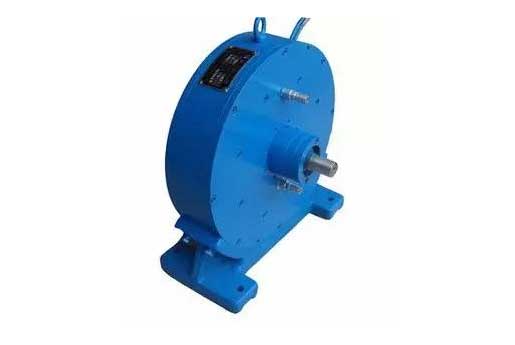
Eddy current brake is the most advanced simulation loading equipment. It is mainly used to simulate the output performance of various power devices. It is composed of an induction disc, armature, and excitation part.
Works Principle
When the excitation coil assembled coaxially with the rotor is supplied with direct current, the magnetic flux generated by it forms a closed loop through the armature body, the eddy current ring, the air gap, and the rotor.
Since the outer surface of the rotor is made with evenly distributed teeth and slots, dense and dense magnetic fields are generated on the surface of the air gap and the armature body or the eddy current ring. Therefore, when the rotor is driven to rotate, the armature body and the eddy current ring The magnetic field at any point on the inner surface produces a variable change, which induces an “eddy current”. Under the coupling action of the “eddy current” and the magnetic field, braking torque is generated on the rotor.
Since the armature body is fixed on the base plate through the base, the rotor cannot drive the armature body to rotate, and the power output by the power machine is converted into the equivalent heat generated by the “eddy current” on the armature body and the eddy current ring. The constant cooling water in the armature body and the eddy current ring cooling water tank and the consumption of the eddy current brake itself.
Corresponding to each constant current of the excitation coil, the eddy current brake shows a stable braking characteristic curve in which the torque depends on the rotational speed. By changing the magnitude of the excitation current, the braking torque can be changed.
Magnetic particle brake
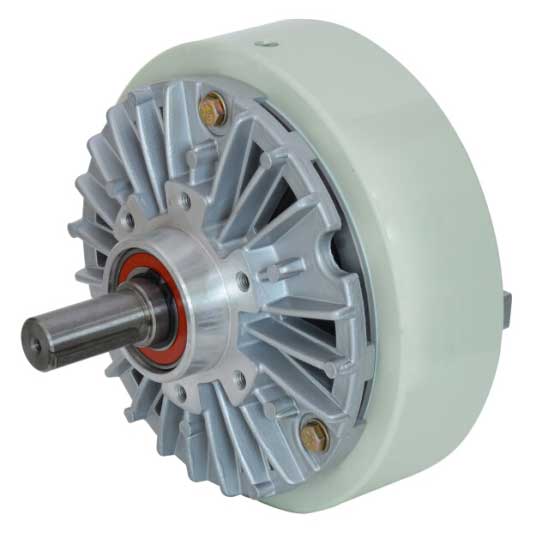
The magnetic particle brake is a new type of transmission element that uses magnetic powder as the medium and forms a magnetic powder chain to transmit torque under the condition of electrification. It is composed of an inner rotor, an outer rotor, an excitation coil, and magnetic particle.
Working principle
When the coil is not energized, the active rotor rotates. Due to the centrifugal force, the magnetic particles are thrown on the inner wall of the active rotor. There is no contact between the magnetic particles and the driven rotor, and the active rotor runs idly. After the DC power supply is turned on, an electromagnetic field is generated, and the magnetic particles of the working medium form a magnetic particles chain under the action of the magnetic force line, which connects the inner rotor and the outer rotor, so as to achieve the purpose of transmitting and braking torque. It can transmit a certain torque irrespective of slip and has the advantages of fast response speed, simple structure, no pollution, no noise, no impact vibration, and energy saving.
Hysteresis brake
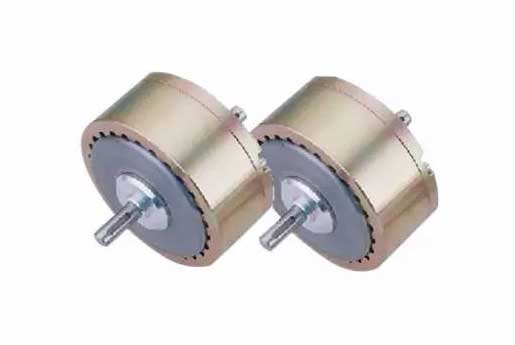
Hysteresis brake consists of two parts: rotor and stator poles. The rotor is made of special hysteresis material. There is a certain gap in the stator poles, and the rotor rotates in the gap. When the coil is energized, a magnetic field is generated in the gap, which causes a hysteresis effect on the rotor. When the hysteresis rotor rotates against the hysteresis force under the action of external force, the rated torque is generated. Torque is only related to the magnitude of the excitation current, not the rotational speed, enabling non-contact torque transmission.
Servo motor
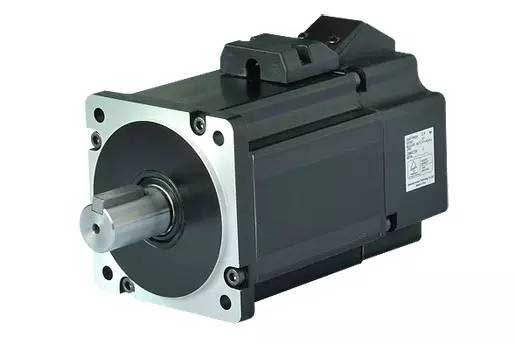
Servo motors are divided into two categories: DC and AC servo motors, which can control the speed and position with high precision, and convert the voltage signal into torque and speed to drive the control object. The rotor speed of the servo motor is controlled by the input signal and can respond quickly. In the automatic control system, it is used as an executive element and has the characteristics of small electromechanical time constant, high linearity, and starting voltage, which can convert the received electrical signal. into the angular displacement or angular velocity output on the motor shaft. Its main feature is that when the voltage signal is zero, there is no self-rotation phenomenon, and the speed decreases uniformly with the increase of torque.
Who is the best?
To choose the most suitable one, it is also necessary to select the appropriate load according to the speed, torque, power, and other attributes of the motor under test and the above-mentioned load suitable for the scene. Each type of load has its own advantages and disadvantages:
- Eddy current: suitable for high-speed and high-power occasions, the maximum speed can support 30,000rpm under 5kw;
- Magnetic particle braking: low price, mainly used in low-speed and high-power occasions, but need to consider the heat dissipation problem, the accuracy is low, and there will be zero drift;
- Hysteresis brake: suitable for high-speed and low-power occasions, the torque range is very small, and the power of about 5kw can only be measured up to 30N.m;
- Servo motor: suitable for occasions with high precision requirements, with good test repeatability and support for energy-feeding loads. The range of speed and torque is not fixed, and the corresponding load motor can be flexibly selected according to the characteristics of the motor under test.
Therefore, according to the test requirements of the motor under test, which load brake to choose is determined by comparing the characteristics of various types of loads.
